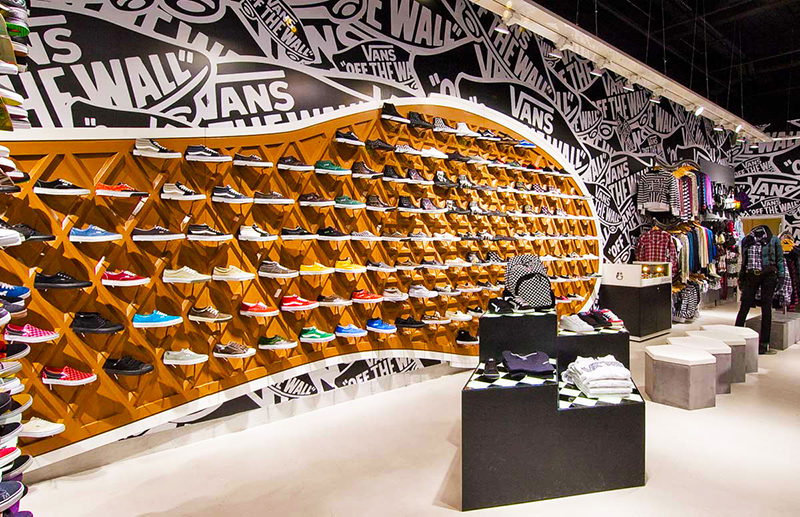By Thomas J. Ryan
<span style="color: #a1a1a1;">VF Corp. reported results for the first quarter ended June 30 that were significantly sidetracked by COVID-19 but still ahead of internal expectations due to strength in international and digital. Indeed, the highlight of the challenging quarter was the widespread digital momentum that drove both sales and consumer engagement.
On a conference call with analysts, Steve Rendle, VF’s chairman, president and CEO, said that while the COVID-19 pandemic has presented “unprecedented challenges and disruption,” it’s also “presented us with the opportunity to accelerate key elements of our strategy.”
This includes VF’s Distort Asia strategy to accelerate growth in Asia. Mainland China has recovered sharply since February with growth at 9 percent in the quarter. Mainland China is expected to accelerate in the mid-teens in the second quarter and achieve more than 20 percent growth for the full year, essentially performing in line with the growth target presented at VF’s Analyst Day meeting last year.
COVID-19 is also presenting opportunities to accelerate VF’s “hyper-digital business model transformation.”
Digital Sales Jump 81 Percent In Q1
VF’s own digital sales vaulted 81 percent on a currency-neutral basis in the first quarter, led by 115 percent growth in the Americas region and nearly 90 percent growth across its big four brands: Vans, The North Face, Timberland, and Dickies.
“As a result of these strong performances, we expect growth in digital of more than 40 percent for the year and coupled with our pure-play digital wholesale business, we expect our digital penetration to be more than 25 percent of fiscal 21 revenue,” said Rendle.
Digital is being supported by the roll-out of BOPIS (buy online, pick up) and ship-from-store capabilities this past quarter in the vast majority of stores in the U.S., but also from heightened engagement online.

Among the digital engagement highlights:
- Eight million new consumers interacted with VF’s brands on Tmall;
- The North Face’s new digital consumers were up 274 percent in the quarter;
- Vans Family loyalty program reached over 12 million members generating a 35 percent higher spend versus non-members; and
- Dickies new digital consumers were up 25 percent in the quarter.
Rendle noted that while VF is “encouraged by the trends in our digital business in the early results,” the company is “early in our digital journey” and sees a “massive opportunity to invest and extend our digital advantage.”
Plans call for the digitization of VF’s entire value chain from design and manufacturing through distribution, better leveraging customer data to inform decisions and tapping digital to elevate product in-store storytelling. Rendle said, “We’ve accelerated our thinking and actions around our digital initiatives in response to the current environment. We know that with our powerful brand portfolio, strengthening our digital enterprise capabilities will fuel accelerated sustainable growth and returns as we emerge from this crisis.”
Regarding current business conditions, Rendle said the company is encouraged by the “improving trend that has continued in July” despite some store re-closures in some parts of the U.S. In the short-term, VF expects another difficult period in the current second quarter with sales expected to be down less than 25 percent, in part due to the re-closures.
But Rendle is more encouraged in the longer term, believing changes in consumer behaviors being accelerated by the pandemic fit squarely into VF’s realignment a few years ago. He said, “Participation in outdoor activities and consumer interest in outdoor exploration is increasing. Health and wellness and the pursuit of a more active lifestyle are accelerating. Casualization is a trend likely to be a mainstay in the post-COVID-19 world. There is an elevated focus on environmental sustainability that will lead to a greater commitment to combating global climate change. And there are growing expectations for purpose-driven actions from brands to care for their local communities and address issues relevant to their consumers.”
He said these underlying trends have influenced VF’s portfolio decisions over the past several years and continue to guide its acquisition agenda. He said, “We believe the portfolio we have today sits at the epicenter of the trends just outlined, and is poised to capitalize on these shifts. And our brands are uniquely positioned to not only benefit from these changes in consumer value systems but have the opportunity to drive and influence them.”
VF’s Q1 Revenues Nosedive 48 Percent
The net loss in the first quarter came to $285.6 million, or 73 cents a share, against earnings of $49.2 million, or 12 cents, a year ago.
On an adjusted basis excluding charges related to the spinoff of Kontoor Brands, its former jeans business, as well as changes to its Occupational Workwear and overall South American business, the adjusted loss came to $230.4 million, or 57 cents a share, exceeding Wall Street’s consensus estimate calling for a loss of 67 cents.
Revenue decreased 48 percent (down 47 percent in constant dollars) to $1.1 billion, exceeding Wall Street’s consensus target of $982 million.
International revenue was down 39 percent (down 37 percent in constant dollars. Europe revenue decreased 48 percent (down 47 percent in constant dollars); Greater China revenue was flat (up 3 percent in constant dollars), including an increase of 5 percent (9 percent in constant dollars) in Mainland China; Direct-to-consumer (DTC) revenue decreased 37 percent despite the digital revenue increase of 78 percent or 81 percent in constant dollars.

Vans Sees 52 Percent Revenue Drop
Active segment revenue decreased 54 percent (down 53 percent in constant dollars) to $571.3 million. The Active segment’s operating profit was $7.1 million, down from $307.6 million a year ago. The segment includes Eagle Creek, Eastpak, JanSport, Kipling, Napapijri, and Vans.
Vans’ revenues were down 52 percent (51 percent in constant dollars) due to decline due to DTC and retail partner store closures in addition to proactive management of wholesale inventories. Vans’ revenue was also impacted by the timing of inventory receipts and delays in product supply although that’s expected to normalize in Q2. Inventory levels in Vans’ largest accounts are below historical levels.
Among channels, Vans’ DTC sales were down 41 percent (40 percent currency-neutral), although DTC Digital jumped 86 percent (89 percent currency-neutral). A regional highlight was APAC, which saw positive currency-neutral growth, led by growth in Greater China, including gains of 9 percent (14 percent currency-neutral) Mainland China
Among products, Vans saw continued relative strength from progression styles Pro Skate, Comfy Cush, and MTE.
By region, Vans was down 64 percent in the Americas. The Americas saw 130 percent currency-neutral DTC Digital growth, driven by strong full price performance and conversion. Sell-through, in open wholesale doors in its largest accounts in the Americas, increased at a high-single-digit rate in May and June despite lower traffic level while Vans DTC reached double-digit growth in June.
Vans’ sales were down 47 percent (46 percent currency-neutral) in Europe and 3 percent (up 1 percent currency-neutral) in APAC. APAC was led by growth in Greater China, including gains of 9 percent (14 percent currency-neutral) Mainland China
For the second quarter, Vans sales are expected to be down less than 15 percent.
The North Face Sees Strength In Equipment
Outdoor segment revenue decreased 44 percent (down 43 percent in constant dollars) to $341.2 million. The segment showed an operating loss of $160.7 million against a loss of $80.7 million a year ago. Outdoor brands include Altra, Icebreaker, Smartwool,
The North Face’s revenues declined 45 percent (44 percent currency-neutral) due to DTC and retail partner store closures and reduced wholesale shipments as a result of COVID-19. DTC revenues were down 29 percent (28 percent currency-neutral), including a gain of 121 percent (124 percent) growth in DTC Digital
The North Face saw strength from broader FutureLight assortment while favorable consumer trends toward outdoor participation led to strength in equipment.
Among regions, sales were down 54 percent in the Americas, off 41 percent (40 percent currency-neutral) in Europe, and down 9 percent (6 percent currency-neutral) in APAC.
In the Americas, The North Face’s DTC Digital growth of 170 percent currency-neutral was supported by a healthcare professionals initiative that drove strong brand sentiment and new customer acquisition. The Americas also saw strong growth in equipment categories, primarily tents, as customers looked to stay closer to home and explore the outdoors.
Continued brand momentum in the EMEA region was marked by 165 percent growth in DTC Digital and acceleration from key digital wholesale accounts. In APAC, Greater China returned to positive currency-neutral growth, up 2 percent with Mainland China ahead 8 percent.
The North Face’s Q2 revenue is expected to be down less than 30 percent with sequential improvement impacted by supply delays and timing of shipments.
Timberland Finding Relative Strength From Outdoor And Classics Footwear
Timberland’s revenues declined 43 percent due to store closures and reduced wholesale shipments. DTC was down 43 percent, including 61 percent (63 percent currency-neutral) growth in DTC Digital. Continued relative strength was seen from Outdoor Footwear and Timberland PRO.
Sales were down 44 percent in the Americas, 50 percent in Europe, and 27 percent in APAC. Strength in the Americas included DTC Digital growth of +100 percent currency-neutral with continued momentum from key Digital Wholesale accounts, up 97 percent. The comparatively-better APAC performance reflects continued improvement in Greater China and Korea. For the second quarter, Timberland’s revenues are expected to be down less than 40 percent with sequential improvement impacted by supply delays and timing of shipments.
Dickies Q2 Revenues Shrink 16 Percent
Work segment revenue decreased 19 percent (down 18 percent in constant dollars), to $162.4 million. The segment showed an operating loss of $11.4 million against a profit of $15.5 million. Work brands include Bulwark Protection, Dickies, Horace Small, Kodiak, Red Kap, Terra, VF Solutions, Walls and ACTIVE.
Dickies’ revenues were down 16 percent (15 percent currency-neutral), impacted by lower wholesale workwear shipments in the Americas and EMEA. Highlights include 21 percent (22 percent currency-neutral) DTC growth, led +43 percent (+45 percent currency-neutral) growth in DTC Digital. Positive currency-neutral growth was seen in APAC, led by 8 percent currency-neutral growth in Mainland China.
Companywide, gross margin decreased 340 basis points to 52.9 percent, primarily driven by elevated promotional activity to clear excess inventory, partially offset by a favorable mix shift toward higher-margin businesses. On an adjusted basis, gross margin decreased 220 basis points to 54.1 percent.
VF ended the quarter with inventories up 2 percent.
The operating loss on a reported basis was $247 million against income of $96.0 million. On an adjusted basis, the operating loss was $230 million.
At the quarter’s end, VF had $2.8 billion of cash and short-term investments in addition to $2.23 billion remaining under VF’s revolving credit facility. Full-year fiscal 2021 free cash flow is still expected to exceed $600 million.
Photos courtesy VF Corp./The North Face/Vans
















